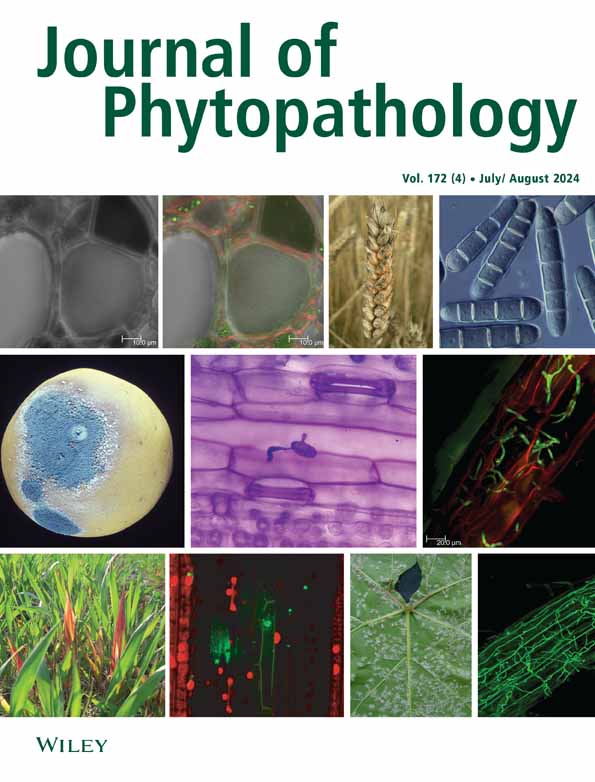First Report of Blast Disease on Hymenachne amplexicaulis Caused by Pyricularia oryzae in Argentina
IF 1.1
4区 农林科学
Q3 PLANT SCIENCES
引用次数: 0
Abstract
In 2022, blast-like symptoms were observed on Hymenachne amplexicaulis plants in Argentina. The causal agent was identified as Pyricularia oryzae based on its cultural and morphometric characteristics, sequencing of the ITS1–5.8S–ITS2 region, phylogenetic analysis, and PCR amplification of the Pot2 transposon marker. Koch's postulates were fulfilled through pathogenicity tests on both H. amplexicaulis and Oryza sativa cv. Guri INTA CL, placing the isolate within a clade that includes P. oryzae strains known to infect Oryza spp. The ITS sequence was deposited in GenBank under accession number OR741771. To the best of our knowledge, this is the first report worldwide of H. amplexicaulis serving as a host for P. oryzae.
阿根廷稻瘟霉引起的大膜片机炸病初报
2022年,在阿根廷的大膜片膜片(Hymenachne amplexicaulis)植物上观察到类似爆炸症状。根据水稻稻瘟病菌的培养和形态特征、ITS1-5.8S-ITS2区测序、系统发育分析和Pot2转座子标记的PCR扩增结果,确定其病原为稻瘟病菌pyricaria oryzae。科赫的假设通过对大镰刀菌和水稻的致病性试验得到了证实。Guri INTA CL,将分离物置于包括已知感染Oryza spp. oryzae菌株的分支中。ITS序列保存在GenBank中,登录号为OR741771。据我们所知,这是世界范围内首次报道的关于大镰刀菌作为米弧菌宿主的报道。
本文章由计算机程序翻译,如有差异,请以英文原文为准。
求助全文
约1分钟内获得全文
求助全文
来源期刊

Journal of Phytopathology
生物-植物科学
CiteScore
2.90
自引率
0.00%
发文量
88
审稿时长
4-8 weeks
期刊介绍:
Journal of Phytopathology publishes original and review articles on all scientific aspects of applied phytopathology in agricultural and horticultural crops. Preference is given to contributions improving our understanding of the biotic and abiotic determinants of plant diseases, including epidemics and damage potential, as a basis for innovative disease management, modelling and forecasting. This includes practical aspects and the development of methods for disease diagnosis as well as infection bioassays.
Studies at the population, organism, physiological, biochemical and molecular genetic level are welcome. The journal scope comprises the pathology and epidemiology of plant diseases caused by microbial pathogens, viruses and nematodes.
Accepted papers should advance our conceptual knowledge of plant diseases, rather than presenting descriptive or screening data unrelated to phytopathological mechanisms or functions. Results from unrepeated experimental conditions or data with no or inappropriate statistical processing will not be considered. Authors are encouraged to look at past issues to ensure adherence to the standards of the journal.
 求助内容:
求助内容: 应助结果提醒方式:
应助结果提醒方式:


